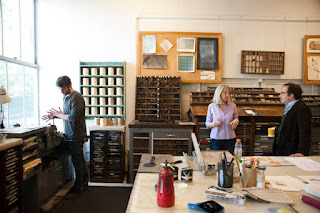Tim and I looking at a stack of dried sheets at the Oakdale facility.
Before meeting with Tim I assumed that the issue was one of too much surface sizing over fibers that were too short, like those found in short cotton linters, or fibers that were not beaten for a long enough period of time. Tim's researches, though, have revealed that a significant amount of classic handmade paper's hardness and snap derives from the use of gelatin sizing and that the sizing also contributes to the paper's durability and stability over time. Of particular interest in his recent research was the discovery that there was considerably more sizing in 15th century papers than there was in paper in subsequent centuries. Gary Frost informed Tim of Szirmai’s assertion, backed up by historical references, in his The Archeology of Medieval Bookbinding, that many 16th century printers were ordering un-sized waterleaf sheets and that the sizing was added after the printing. The post-press addition of sizing would make the papers more durable for binding and more resistant to ink-bleed when people wrote in the margins. This is interesting to me because it relates to my experience of the Losiny: I needed the lack of sizing for the paper to print the way I wanted but afterward I would have liked some (not all) of the physical attributes that the sizing imparts to the finished sheet. When Annie and I return to New York I am going to send Tim some of the rejected sheets from Specimens to experiment with re-applying gelatin sizing.
The loft drying system (above) and fiber cook pots (below) at Oakdale.
After visiting Oakdale, Tim brought us back to the campus to meet up with Sara Sauers for a tour of the Center for the Book. Sara teaches letterpress printing at Iowa, has her own press (check out her new book for the Folger Shakespeare Library, Shakespeare's Sisters), and was the person with whom I arranged the visit. The Center for the Book facilities are built into the North Hall, a former secondary school that has been cleverly re-purposed, most notably the former men's locker room which is now the wet floor of the student papermaking studio. We took a look around, met and re-met up with other instructors at the Center—Emily Martin, Sara Langworthy, Gary Frost, Lauren Faulkenberry, and Julie Leonard—and then got together with the students to show some books and talk about the FPBA. As has been my experience at the other university programs I've visited so far, the Iowa students are engaged and serious. Before I began visiting MFA Book Arts students last fall I was worried that the proliferation of academic book arts was going to be a passing fad. Instead, with each one I visit I am more hopeful for the future of the handmade book. The remainder of the day was divided between various dining experiences with Sara, Sara, and Tim.
Sara Sauers and I at the student printshop at North Hall.
Showing books to students in the student papermaking studio at North Hall.








